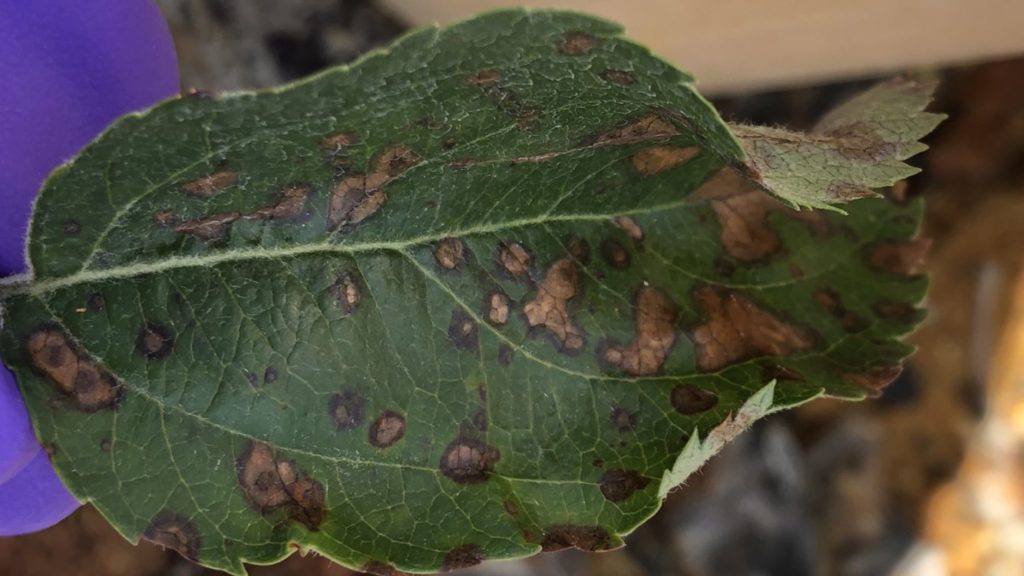Apple Disease Update: May 14, 2020
go.ncsu.edu/readext?691477
en Español / em Português
El inglés es el idioma de control de esta página. En la medida en que haya algún conflicto entre la traducción al inglés y la traducción, el inglés prevalece.
Al hacer clic en el enlace de traducción se activa un servicio de traducción gratuito para convertir la página al español. Al igual que con cualquier traducción por Internet, la conversión no es sensible al contexto y puede que no traduzca el texto en su significado original. NC State Extension no garantiza la exactitud del texto traducido. Por favor, tenga en cuenta que algunas aplicaciones y/o servicios pueden no funcionar como se espera cuando se traducen.
Português
Inglês é o idioma de controle desta página. Na medida que haja algum conflito entre o texto original em Inglês e a tradução, o Inglês prevalece.
Ao clicar no link de tradução, um serviço gratuito de tradução será ativado para converter a página para o Português. Como em qualquer tradução pela internet, a conversão não é sensivel ao contexto e pode não ocorrer a tradução para o significado orginal. O serviço de Extensão da Carolina do Norte (NC State Extension) não garante a exatidão do texto traduzido. Por favor, observe que algumas funções ou serviços podem não funcionar como esperado após a tradução.
English
English is the controlling language of this page. To the extent there is any conflict between the English text and the translation, English controls.
Clicking on the translation link activates a free translation service to convert the page to Spanish. As with any Internet translation, the conversion is not context-sensitive and may not translate the text to its original meaning. NC State Extension does not guarantee the accuracy of the translated text. Please note that some applications and/or services may not function as expected when translated.
Collapse ▲Apologies for the delayed post this week. Between the cold temps and paucity of good thinning this year, it seems like my hort. sci. colleagues were the ones in the hot seat this week. Nonetheless, there are a few disease updates/observations that I think are important to point out this week.
First-as far as normal maintenance applications go…The forecast next week looks like rain and daytime temperatures in Western NC of 65-80 F are predicted. If there are ascospores of the GLS/bitter rot pathogen that are hanging out on tree litter on the ground and have not yet been released, the rain will likely release them. Make sure your trees are protected. Since it also looks like we will have 4 to 5 days of rain in a row, you may want to consider a Merivon application no later than this Sunday (5/17) if you did not apply it yet this season or if you did not apply it last spray. Make sure to combine with either mancozeb (77 day PHI) or half-rate of captan for resistance management. If you did apply it last week, consider either captan + mancozeb OR mancozeb + Aprovia or Fontelis. If you go the captan + mancozeb route, just keep in mind you may have to go out and reapply once the rain ends.
I’ve recently heard a bit of chatter that apple scab is not a big concern across the southeast this year because of the cool weather. As your apple pathologist, I beg you to please refrain from letting your guard down. At this time last year, we had 6 scab infection events, compared to this year in which 12 infection events have been forecasted. Certainly, both active ingredients in most SDHI/QoI premix products (e.g. Merivon, Luna Sensation) provide excellent scab control. Aprovia and Miravis (SDHI fungicides) have provided an outstanding level of scab control. If you are scouting and notice any infections, considering an application of one these products with either captan or mancozeb.
Lastly, I want to bring your attention to Frogeye leaf spot (photograph at top of this post). For those of you who are not as familiar with Frogeye, it is caused by the fungus Botryosphaeria obtusa- the same pathogen causing black rot on your fruit (see photo directly above) and the pathogen we most commonly associate with black rot of the woody tissue in apple trees. So far, Cameo, Honeycrisp, and Evercrisp have been particularly hard hit.
The first symptoms of frogeye leaf spot appear as small purple spots. The lesions will expand as the disease progresses and remain fairly circular. More mature lesions become more of a tan color with a purple margin. Frequently, a dark dot is evident in the center of the lesion, which gives the lesion a frogeye appearance. Since this is the second season in a row I’ve seen higher than normal levels of diseases caused by B. obtusa, I want to alert you to the issue and make sure you are prepared to manage the disease. Captan, strobilurin (FRAC 11) fungicides, and thiophanate methyl are currently the best options. Sanitation measures such as mummy removal, pruning of dead wood, and limiting tree stress should also mitigate disease. If you have problems in some of your blocks this year, a fungicide program aimed at frogeye control should be addressed next year as green tissue begins to emerge.





